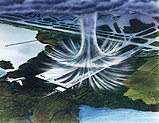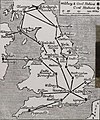Portal:Aviation
| Main page | Categories & Main topics |
|
Tasks and Projects |
The Aviation Portal

Aviation includes the activities surrounding mechanical flight and the aircraft industry. Aircraft includes fixed-wing and rotary-wing types, morphable wings, wing-less lifting bodies, as well as lighter-than-air aircraft such as hot air balloons and airships.
Aviation began in the 18th century with the development of the hot air balloon, an apparatus capable of atmospheric displacement through buoyancy. Some of the most significant advancements in aviation technology came with the controlled gliding flying of Otto Lilienthal in 1896; then a large step in significance came with the construction of the first powered airplane by the Wright brothers in the early 1900s. Since that time, aviation has been technologically revolutionized by the introduction of the jet which permitted a major form of transport throughout the world. (Full article...)
Selected article
Wind shear itself is a microscale meteorological phenomenon occurring over a very small distance, but it can be associated with mesoscale or synoptic scale weather features such as squall lines and cold fronts. It is commonly observed near microbursts and downbursts caused by thunderstorms, weather fronts, areas of locally higher low level winds referred to as low level jets, near mountains, radiation inversions that occur due to clear skies and calm winds, buildings, wind turbines, and sailboats. Wind shear has a significant effect during take-off and landing of aircraft due to their effects on steering of the aircraft, and was a significant cause of aircraft accidents involving large loss of life within the United States.
Sound movement through the atmosphere is affected by wind shear, which can bend the wave front, causing sounds to be heard where they normally would not, or vice versa. Strong vertical wind shear within the troposphere also inhibits tropical cyclone development, but helps to organize individual thunderstorms into living longer life cycles which can then produce severe weather. The thermal wind concept explains with how differences in wind speed with height are dependent on horizontal temperature differences, and explains the existence of the jet stream. (Full article...)
Selected image
Did you know
...that five USAAF airmen were awarded the Medal of Honor following Operation Tidal Wave, a low-level bombing of Romanian oil refineries on 1 August 1943? ...that the fighter pilot Aleksandr Kazakov destroyed 32 German and Austro-Hungarian planes during WWI, while his formal tally of 17 is explained by the fact that only planes crashed in the Russian-held territory were officially counted? ... the Safety Promotion Center, established by Japan Airlines after the worst single aircraft accident in history, has passengers' farewell letters and wreckage on display to educate employees about safety?
General images -
In the news
- May 29: Austrian Airlines cancels Moscow-bound flight after Russia refuses a reroute outside Belarusian airspace
- August 8: Passenger flight crashes upon landing at Calicut airport in India
- June 4: Power firm helicopter strikes cables, crashes near Fairfield, California
- January 29: Former basketball player Kobe Bryant dies in helicopter crash, aged 41
- January 13: Iran admits downing Ukrainian jet, cites 'human error'
- January 10: Fire erupts in parking structure at Sola Airport, Norway
- October 27: US announces restrictions on flying to Cuba
- October 3: World War II era plane crashes in Connecticut, US, killing at least seven
- September 10: Nevada prop plane crash near Las Vegas leaves two dead, three injured
- August 6: French inventor Franky Zapata successfully crosses English Channel on jet-powered hoverboard
Related portals
Associated Wikimedia
The following Wikimedia Foundation sister projects provide more on this subject:
-
Commons
Free media repository -
Wikibooks
Free textbooks and manuals -
Wikidata
Free knowledge base -
Wikinews
Free-content news -
Wikiquote
Collection of quotations -
Wikisource
Free-content library -
Wikiversity
Free learning tools -
Wikivoyage
Free travel guide -
Wiktionary
Dictionary and thesaurus
Selected biography
Erich Alfred "Bubi" Hartmann (19 April 1922 – 20 September 1993), also nicknamed "The Blond Knight of Germany" by friends and "The Black Devil" by his enemies, was a German fighter pilot and still is the highest scoring fighter ace in the history of aerial combat. He scored 352 aerial victories (of which 345 were won against the Soviet Air Force, and 260 of which were fighters) in 1,404 combat missions and engaging in aerial combat 825 times while serving with the Luftwaffe in World War II. During the course of his career Hartmann was forced to crash land his damaged fighter 14 times. This was due to damage received from parts of enemy aircraft he had just shot down, or mechanical failure. Hartmann was never shot down or forced to land due to enemy fire.[1]
Hartmann, a pre-war glider pilot, joined the Luftwaffe in 1940 and completed his fighter pilot training in 1942. He was posted to Jagdgeschwader 52 (JG 52) on the Eastern front and was fortunate to be placed under the supervision of some of the Luftwaffe's most experienced fighter pilots. Under their guidance Hartmann steadily developed his tactics which would earn him the coveted Knight's Cross of the Iron Cross with Oak Leaves, Swords and Diamonds on 25 August 1944 for claiming 301 aerial victories.
He scored his 352nd and last aerial victory on 8 May 1945. He and the remainder of JG 52 surrendered to United States Army forces and were turned over to the Red Army. Convicted of false "War Crimes" and sentenced to 25 years of hard labour, Hartmann would spend 10 years in various Soviet prison camps and gulags until he was released in 1955. In 1956, Hartmann joined the newly established West German Luftwaffe and became the first Geschwaderkommodore of Jagdgeschwader 71 "Richthofen". Hartmann resigned early from the Bundeswehr in 1970, largely due to his opposition of the F-104 Starfighter deployment in the Bundesluftwaffe and the resulting clashes with his superiors over this issue. Erich Hartmann died in 1993.
Selected Aircraft

The Airbus A340 is a long-range four-engined widebody commercial passenger airplane manufactured by Airbus. The latest variants (-600 & A340E) competed with Boeing's 777 series of aircraft on long-haul and ultra long-haul routes, but it has since been succeeded by the Airbus A350.
The A340-600 flies 380 passengers in a three-class cabin layout (419 in 2 class) over 7,500 nautical miles (13,900 km). It provides similar passenger capacity to a 747 but with twice the cargo volume, and at lower trip and seat costs.
The A340-600 is more than 10 m longer than a basic -300, making it the second longest airliner in the world, more than four meters longer than a Boeing 747-400.
- Span: 63.45 m (208 ft 2 in)
- Length: 75.30 m n(246 ft 11 in)
- Height: 17.30 m (56 ft 9 in)
- Engines: four 56,000 lbf (249 kN) thrust Rolls-Royce Trent 556 turbofans
- Cruising Speed: Mach 0.83 (885 km/h, 550 mph)
- First Flight: October 25, 1991
Today in Aviation
- 2012 – Syrian rebel forces attack a Syrian government airbase 15 kilometers (9.3 miles) outside Damascus, and claim to have destroyed two helicopters on the ground.[2]
- 2009 – First flight of the Gulfstream G650
- 1985 – Aeroflot Antonov An-12 shoot-down: South African Special Forces use a shoulder-launched surface-to-air missile to shoot down a Soviet Antonov An-12 carrying 21 people 43 km (27 miles) east of Menongue, Angola. All aboard the aircraft die.
- 1975 – Israeli Air Force Lockheed C-130H Hercules 203/4X-FBO, c/n 4533, crashed into Mount Jebel Halal, 55 kilometers south-southeast of El Arish, Sinai Peninsula. Pilots were Shaul Bustan and Uri Manor.
- 1973 – KLM Flight 861, called “Mississippi”, was a Boeing 747 that was hijacked by three young Arabs over Iraqi airspace on a scheduled Amsterdam-Tokyo flight with 247 passengers on board. The hijackers threatened to blow up the plane when no country would grant landing permission. Most of the passengers and the eight stewardesses were released after negotiations with the Maltese PM Dom Mintoff. With 11 passengers on board the jumbo jet left Malta to Dubai where the incident ended without fatalities. The hijack was claimed by the Arab Nationalist Youth Organization.
- 1961 – The US Navy's first nuclear powered aircraft carrier, USS Enterprise is commissioned.
- 1961 – The first crash of the CF-104 during the test flight from Canadair. The pilot ejected safely.
- 1956 – Eight Boeing B-52 s complete a record nonstop flight of 17,000 miles over the North Pole.
- 1956 – U. S. Air Force Sergeant Richard Patton makes the first successful parachute jump in Antarctica. He jumps from 1,500 feet as a test to determine the cause of parachute malfunction in sub-zero weather conditions.
- 1950 – The People’s Republic of China launches a major offensive across the Yalu River against United Nations forces in Korea. Under terrible winter weather conditions, United Nations aircraft are heavily committed to supporting ground forces, which are driven out of northern Korea by the end of the year.
- 1944 – Aircraft from seven aircraft carriers of Task Force 38 carry out the task force’s last raids in support of the Leyte campaign, raiding Japanese bases on Luzon, attacking a coastal convoy, and destroying 26 Japanese aircraft in the air and 29 on the ground. Aircraft from USS Ticonderoga (CV-14) sink the Japanese heavy cruiser Kumano in Dasol Bay. Kamikazes respond by damaging the aircraft carriers USS Intrepid (CV-11), USS Essex (CV-9), and USS Cabot (CVL-28); damage to the carriers forces cancellation of strikes against Japanese shipping in the Visayas the next day.
- 1943 – (Overnight) Japanese aircraft attack American ships east of the Gilbert Islands, scoring no hits.
- 1940 – First flight of the de Havilland Mosquito
- 1940 – First flight of the Martin B-26 Marauder
- 1930 – First flight of the Fairey Hendon
- 1930 – Canadian Airways Ltd. acquired companies controlled by the Aviation Corporation of Canada and Western Canada Airways.
- 1924 – The dirigible LZ 126 is commissioned into the U. S. Navy as USS Los Angeles (ZR-3) at Naval Air Station Anacostia in Washington, D. C.
- 1913 – Raymonde de Laroche flies 200 miles (320 km) solo in four hours. The flight will win her the 1913 Fémina Cup for the longest solo flight by a woman that year.[4]
References
- ^ Toliver & Constable 1986, p. 12.
- ^ Rebels seize “large part” of army airport near Damascus, NGO says," nowlebanon.com, November 25, 2012
- ^ "1996 USAF Serial Numbers". Retrieved 2010-02-17.
- ^ "Mme de Laroche gagne la Coup Femina". La Revue aérienne (in French). Dec 10, 1913. p. 669. Retrieved Nov 29, 2017.
- Shortcuts to this page: Portal:Airplanes • P:AVIA





















































